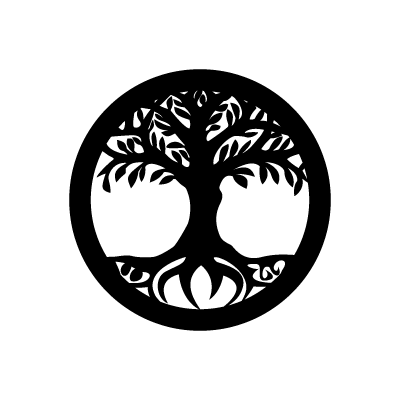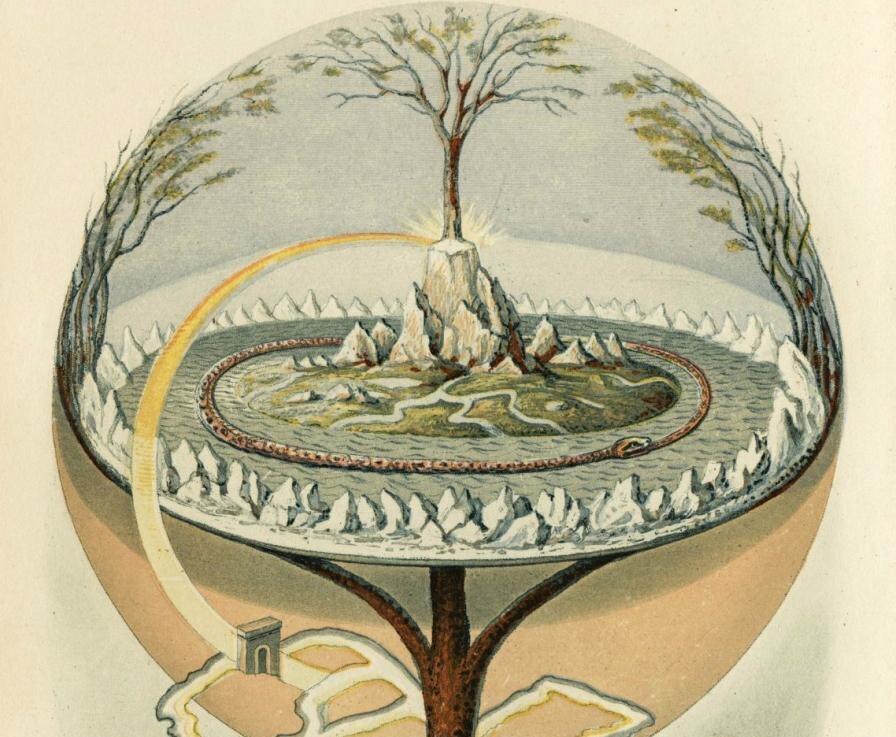Yggdrasil is a huge and sacred ash tree according to Norse cosmology. It is the focal point of the Viking world, where the gods hold their daily "things" or parliamentary assemblies. The tree's branches reach into the heavens, and its roots run deep underground, containing the nine realms of the Norse world between them.
Yggdrasil Pronunciation
The Old Norse pronunciation of Yggdrasil would sound like “eeg-dra-seal” (Vikings also liked to roll the “r”), breaking the word up into three syllables.
Other Names for the Norse World Tree
Experts have theorized that Hoddmímis Holt, Mímameiðr, and Laeraðr are other names for the tree.
Mímameiðr appears in the Old Norse poem Fjölsvinnsmál, and researchers consider it an alias of Yggdrasil due to similarities in their descriptions.
In the poem, Vafþrúðnismál, part of the Poetic Edda, the man, and woman Lif and Lifthrasir emerge from their hiding place called Hoddmímis Holt in the aftermath of Ragnarök. Their destiny is to start the repopulation of humanity.
Carolyne Larrington, Professor of Medieval European Literature at St John’s, Oxford, states, “it is possible that Hoddmimir is another name for Mimir and that the two survivors hide in Yggdrasill.”
Heiðrún produces the never-ending supply of mead to the einherjar in Valhalla after eating leaves from the tree Læraðr, probably a different name for Yggdrasil.
The Norse Myth of the World Tree – Yggdrasil
The Nine Realms
Norse mythology dictates nine realms sit in the branches or the roots of Yggdrasil, the World Tree. Of these nine, six are constant and feature in every image or description of the realms: Asgard, Alfheim, Vanaheim, Midgard, Jotunheim, and Muspelheim.
The other three are a selection of Svartalfheim and Niðavellir or Hel and Niflheim. Svartalfheim and Niðavellir are sometimes combined, as are Hel and Niflheim.

Make sure to also check the following articles:
Position of the 9 nine realms
There is some confusion about the positions of the various realms within Norse mythology. The placement of Vanaheim, for example, can vary depending on which map you use. However, the most common positions of the nine worlds are as follows:
Asgard always lies in the highest and central section of Yggdrasil. Vanaheim and Alfheim usually flank it. Directly below Asgard lies Midgard. The tree trunk usually connects the two places, so the Bifrost or rainbow bridge can join them.
Further down, we have Jotunheim (land of the ice giants), Muspelheim (land of fire giants and the god Surtr), and Niflheim (containing Hel).
The Wells and Spring
According to the Prose Edda, compiled by the Icelandic politician, historian, and poet Snorri Sturluson, two wells and a spring sit within the roots of Yggdrasil: Urðarbrunnr, Mímisbrunnr, and Hvergelmir.
Urðarbrunnr
Urðarbrunnr was the name of the well where the Norns gathered. The Norns were a trio of giant goddesses in Norse mythology who controlled human destiny; their names were Urðr (or Urd), Verðandi (or Verdandi), and Skuld. Urðr influenced the past, Verðandi the present, and Skuld the future.
Mímisbrunnr
The other well was Mímisbrunnr, which sat underneath the root of Yggdrasil, leading to the giants’ realm Jotunheim. It was the domain of Mímir, esteemed for his exceptional knowledge and wisdom.
Hvergelmir
Hvergelmir was a spring reputed to be the source of all rivers in the nine realms and fed by the antlers of the stag Eikþyrnir. The spring lay in the tree roots near Niflheim and was home to snakes and the dragon Níðhöggr.
The Creatures of Yggdrasil
Many creatures lived in Yggdrasil’s branches and roots.
Níðhöggr
Níðhöggr (or Nidhogg) lurked trapped beneath the World Tree’s roots, trying to bite through them to escape. It could move into the realm of Hel, as descriptions had its consuming corpses there.
Duneyrr, Dvalinn, Dáinn, and Duraþrór
Duneyrr, Dvalinn, Dáinn, and Duraþrór were four stags who ate the tree’s leaves.
Veðrfölnir
Veðrfölnir was a hawk perched between an unknown eagle’s eyes that sat high up in the tree.
Ratatoskr
The squirrel Ratatoskr (or Ratatosk) ran errands between Níðhöggr and the eagle.
Yggdrasil Symbol

Yggdrasil Meaning and Etymology
The commonly accepted interpretation of the Old Norse word “Yggdrasill” is “Horse of Odin,” meaning “gallows” or “gibbet. “This theory comes about because “drasill” means “horse,” and “Ygg” is one of Odin’s numerous aliases.
The Poetic Edda poem Hávamál tells the story of Odin hanging himself from a tree in his never-ending quest for knowledge. This tree may have been Yggdrasil and consequently received the name of “Odin’s gallows.” The passage reads thus:
I trow I hung on that windy Tree
Pocket Hamaval – Olive Bray
nine whole days and nights,
stabbed with a spear, offered to Odin,
to my own self given,
high on that tree of which none hath heard
from what roots it rises to heaven.
Scholars have referred to gallows or gibbets as “the horse of the hanged.” From there, the expression may have developed in the phrase “Odin’s horse, “which in turn became the name of the tree.
“Askr Yggdrasils,” the full name of the tree, sometimes appears. The translation of “askr” is “ash tree.”
Ferdinand Detter (1864-1904), a professor of German culture at Prague University, believes the Old Norse word for “terror” (“yggr”) could mean “Yggdrasil,” “tree of terror.”
German philologist Franz Rolf Schröder postulates that “Yggdrasill” means “yew column” since “ygg” is like “yggia,” Old Norse for “yew.”
Yggdrasil Attestations
Poetic Edda
In the second stanza of Völuspá, a poem in the Poetic Edda, a völva recites a poem to Odin about a tree:
An ash I know there stands,
The World Tree in Literature – World Tree Project Org
Yggdrasill is its name,
a tall tree, showered
with shining loam.
From there come the dews
that drop in the valleys.
It stands forever green over
Urðr’s well.
Stanza 31 of Grímnismál tells us Hel lies underneath one of the three roots of Yggdrasil.
Prose Edda
In chapter 15 of Gylfaginning, Hár (one of Odin’s many aliases) tells Gangleri (King Gylfi, also in disguise) about Mímir the wise and his well.
The Æsir, Odin, was obsessed with acquiring all the wisdom of the nine worlds and had heard stories about a well called Mímisbrunnr situated in Jotunheim underneath the second root of the World Tree Yggdrasil. The well was said to be the source of wisdom of the jötunn Mímir who guarded it, and Odin was desperate to retrieve it, so he journeyed to the giants’ realm to bring it home.
Mímir was an ancient being famous throughout the nine worlds for his wisdom. When Odin arrived at the well and requested to drink from it, Mímir told him that he would only allow Odin to do so if he removed one of his eyes and gave it to him.
Odin agreed, removed an eye, and handed it over. Mímir placed the eye in Mímisbrunnr after Odin left.
Chapter 52 of Gylfaginning describes how the cataclysmic events of Ragnarök unfold: violent storms and earthquakes make even the World Tree Yggdrasil shake.
Other
In stanza 6 of the poem Hrafnagaldr Óðins, an Icelandic poem in the style of the Poetic Edda, the World Tree is mentioned:
In the dales dwells, the prescient Dís, from Yggdrasil’sash sunk, of alfen race, Idun by name, the youngest of Ivaldi’s elder children.
Iðunn – Wattpad

